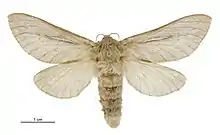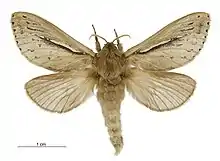| Wiseana umbraculata | |
|---|---|
 | |
| Female specimen | |
 | |
| Male specimen | |
| Scientific classification | |
| Domain: | Eukaryota |
| Kingdom: | Animalia |
| Phylum: | Arthropoda |
| Class: | Insecta |
| Order: | Lepidoptera |
| Family: | Hepialidae |
| Genus: | Wiseana |
| Species: | W. umbraculata |
| Binomial name | |
| Wiseana umbraculata Guenée, 1868) | |
| Synonyms | |
| |
.jpg.webp)
Wiseana umbraculata, also known as the bog porina, is a species of moth belonging to the family Hepialidae.[1] There are seven endemic species and three haplotypes of Wiseana in New Zealand including bog porina.[2] It was regarded as being common in Whanganui in the early twentieth century.[3]
Description
The wingspan is 38–50 mm for males and 49–66 mm for females. Forewing colour varies, but is usually fawn, pinkish fawn or infuscate. The hindwings are pinkish-fawn to yellow-fawn.[4] Adults are on wing from September to April.[5] Adult male and female bog porina can be told apart as the males are much darker in colour and have noticeable dark spots on their forewings. The females are lighter in colour with brown dots on their forewings. Caterpillars of W. umbraculata have a brown head with a dirty white and grey body.[4] Without DNA technology, it is not possible to tell the different species of porina apart at the larval/caterpillar stage.[2]
Distribution
Bog porina occur throughout New Zealand; however, they are uncommon in the northern half of the North Island. W. umbraculata occupy habitats ranging from alpine regions to lowland plains.[6] They are distributed from the central North Island to the bottom of the South Island. The larvae live in pasture, and can be very damaging.[4] The preferred habitat for eggs and caterpillars is long dense pasture. They thrive in warm, moist conditions. Very hot, dry weather can decimate young porina populations, especially in short open pastures.[6]
Life cycle
Adult porina moths mate as soon as they emerge from the soil after completing the larval stage.[4] The moths fly in spring, summer, and early autumn depending on location.[4] The moths do not feed and only live a few days. During these few days, the female moth flies over pastures and releases around 3000 eggs. Her eggs will hatch within a few weeks.[4] At first the newly hatched caterpillars will live above ground. They spend about 5 weeks on top of the soil feeding on plant matter and microflora.[4] As the caterpillars grow larger, they burrow beneath the soil and construct permanent silk burrows which can reach a depth of around 30cm.[7] They will emerge from these burrows at night to feed. They sever grass and clover leaves at the base of the plant and drag them back to their burrow to consume.[4] Porina caterpillars will moult seven or eight times over their lifetime. Development from egg to adult takes 12 months.[4]
Interactions
Porina are grazers, and are direct competitors with stock for food. Food plants for the larvae include species of grass. The larvae of W. umbraculata are regarded as a major pasture pest.[8] Bog porina are prone to several diseases. Porina numbers are strongly influenced by diseases from naturally occurring pathogens in pasture. Many pathogens are dependent on porina.[4] For pathogens to be effective, porina must be present in sufficient but not damaging numbers. In a stable environment such as tussock grasslands, porina pathogens regulate porina numbers so densities remain low.[4] Under natural conditions, the Wiseana nucleopolyhedrosis virus can cause larval mortalities of up to ninety percent.[7] Nucleopolyhedrosis virus causes larvae to swell with fluid and eventually die before decomposing.[7] At the larval stage, porina will concentrate their foraging behaviours as close to the burrow entrance as possible. This results in the plants surrounding the burrow to be overgrazed and creates bare patches in the pasture.[9]
Further information
Heavy stocking and close grazing in the summer can reduce the survival of eggs and larvae. There are a few grasses which are not palatable to porina. Such as particular ryegrasses, cocksfoot and tall fescue.[9] Having these grasses present in pasture will decrease the number of porina resulting in less pasture damage.[4]
References
- ↑ "Wiseana umbraculata". www.nzor.org.nz. Landcare Research New Zealand Ltd.
- 1 2 Richards, Nicola K; Mansfield, Sarah; Townsend, Richard J; Ferguson, Colin M (2017). "Genetic variation within species and haplotypes of the Wiseana (Lepidoptera: Hepialidae) complex and development of non-sequenced based identification tools to aid field studies: Identification of species and haplotypes of the Wiseana complex". Pest Management Science. 73 (11): 2334–2344. doi:10.1002/ps.4620. PMID 28544267.
- ↑ Watt, Morris N. (1 January 1913). "Ova of some of the Lepidoptera of the New Zealand". Transactions and Proceedings of the New Zealand Institute. 46: 67.
- 1 2 3 4 5 6 7 8 9 10 11 12 "AgPest » Porina".
- ↑ Dugdale, J. S. (1994). "Hepialidae (Insecta: Lepidoptera)" (PDF). Fauna of New Zealand. 30: 69–70.
- 1 2 Ferguson, Colin (May 2019). "Identification and management of porina" (PDF). beef + lamb New Zealand.
- 1 2 3 Moore, S. G.; Kalmakoff, J.; Miles, J. A. R. (March 1974). "Virus diseases of porina ( Wiseana spp.; Lepidoptera: Hepialidae): ∗2. Transmission trials". New Zealand Journal of Zoology. 1 (1): 85–95. doi:10.1080/03014223.1974.9517817. ISSN 0301-4223.
- ↑ Popay, Alison. "Insect pests of crops, pasture and forestry : Endemic pests of pasture". Teara.govt.nz. Government of New Zealand.
- 1 2 "Home | Homepage Beef + Lamb New Zealand". beeflambnz.com.
 Media related to Wiseana umbraculata at Wikimedia Commons
Media related to Wiseana umbraculata at Wikimedia Commons Data related to Wiseana at Wikispecies
Data related to Wiseana at Wikispecies